The Big Push for Policy Wins
septiembre 14, 2016
No ofrecemos comida. Aquí es donde puedes Encuentre comida gratis aquí.
No distribuimos alimentos. Encuentre comida gratis aquí.
我們不直接提供食物,但我們能幫助您找尋食物。

Policy advocates can feel a lot like Sisyphus. Much like the mythic character who never pushes the boulder to the top, our task can seem like an endless, arduous uphill battle, and just when you think you’ve made it, you find yourself at the bottom starting all over again.
That’s how it felt for CAFB policy staff and many of our member food banks who have been advocating for two important initiatives over the past several years, and nearly—but not quite—succeeding each legislative session. Our 2015 effort to extend the vital tax credit for farmers to donate excess crops to food banks, for example, received unanimous support in the Legislature before seeing a Governor’s veto unrelated to the merits of our bill. Similarly, in 2014 and 2015 we’d seemingly secured funding for the State Emergency Food Assistance Program (SEFAP), that allows food banks to purchase healthy California grown foods, but it was axed from final budget negotiations.
This year we’ve broken free from the myth and our perseverance has paid off as we achieved several important wins in Sacramento:
♦ The Farm to Food Bank tax credit. As the existing credit was set to expire at the end of 2016, action was imperative in this legislative session and we were thrilled to realize much of our agenda in the 2016-17 state budget. Altogether, these changes are expected to generate some $5 million in donations over the next 5 years, doubling the performance of the existing credit:
♦ SEFAP. The budget also allocates $2 million for emergency food providers in every one of California’s 58 counties to purchase healthy, California grown foods to those in need.
♦ SSI/SSP. The Supplemental Security Income program, which in California includes a State Supplemental Payment, is a basic assistance program that serves 1.3 million low-income Californians who are blind, elderly, or living with a disability. The program is a lifeline but has been slashed to the absolute federal minimum since the Great Recession when the state cut grants and the Cost of Living Adjustment (COLA) to help balance the budget. The budget includes the first COLA in 10 years, a much-needed $4 a month boost for recipients in 2017. An addition $45 million for Advocacy programs will be used to house SSI applicants and provide legal services to help during the 1-2 year application and appeals process, improving our low participation rate among those eligible for the program.
Another hallmark of advocacy is that you rarely get exactly what you ask for, and this year was no different. While we celebrate this victories, we will continue to advocate for the full policy actions needed to move the needle on hunger in California.
— The tax credit: At the end, it was not possible to make eligible additional foods beyond produce, such as proteins, dairy, rice, beans or other products that are vital to a healthy diet. The state, understandably, wants to first assess how the new changes affect donations. These products that are necessary for complete nutrition will be a priority going forward, however.
— SEFAP: We had asked the state to provide a proportionate response to hunger by making a $10 million annual investment in SEFAP, but in budget deliberations this was reduced to $2 million. A $10 million investment would translate to 50 million meals statewide, a robust but manageable increase on the 650 million meals that California food banks distribute every year.
— SSI/SSP: While the $4 a month COLA is a critical first step, we have a long way to go to closing the $77 a month overall loss in benefits that recipients have experienced.
Even though our victories could have pushed further, it’s important to stop and share these advocacy achievements of CAFB and our network of food banks who partner with us in advocacy efforts.
Onward to our next advocacy challenge – expanding our first line of defense against hunger, the CalFresh program (SNAP nationally), in the Farm Bill!
Escrito por Andrew Cheyne, Director de Asuntos Gubernamentales